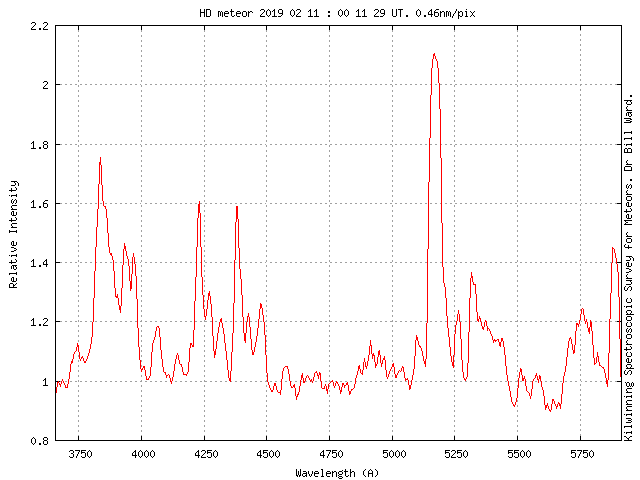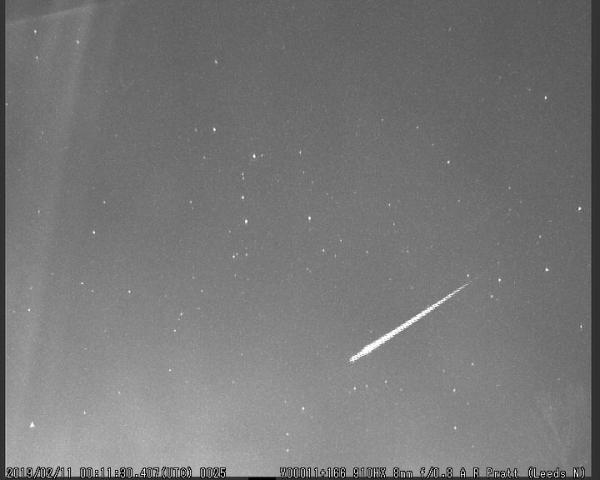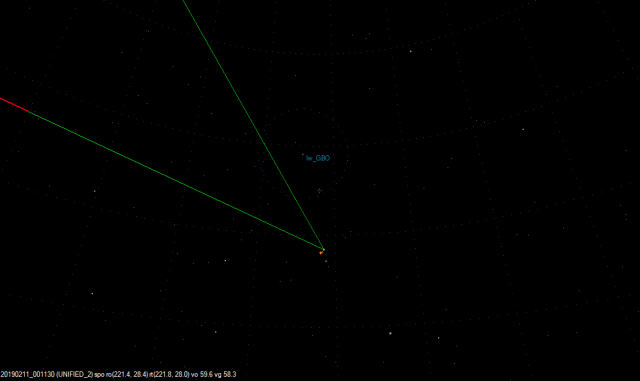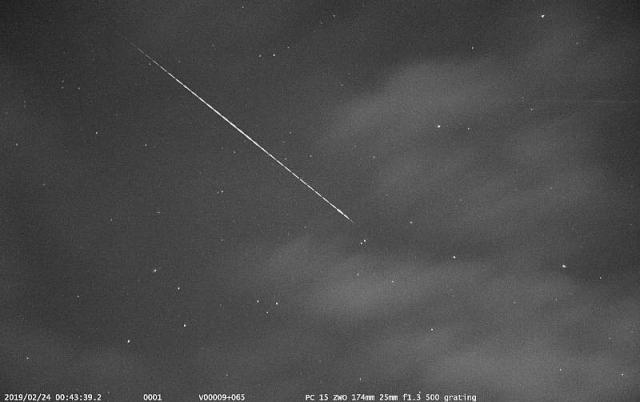- This topic has 13 replies, 4 voices, and was last updated 5 years, 1 month ago by
 Bill Ward.
Bill Ward.
-
AuthorPosts
-
11 February 2019 at 6:26 pm #574249
 Bill WardParticipant
Bill WardParticipantHi,
There are still some driver issues (and those issues are well beyond my understanding of how the software does what it does!!!) however after some tinkering with the camera settings I got my new ZWO174MM camera to work with UFO Capture HD.
Using only cheap plastic grating film as a test I caught my first HD spectrum.

This is a stretched crop of the frame, unfortunately the graphic re-sizing here kills off some of the improvements….
On the full size original the H+K ionised calcium lines are split and if the dispersion angle had been better the Mg triplet “might” have been resolved. Also more of the close Fe lines would be resolved.
So, there is potential for continuing improvements towards sub nm resolution!
cheers,
Bill.
Attachments:
11 February 2019 at 10:19 pm #580665 Bill WardParticipant
Bill WardParticipantAfter a bit of processing…

What I think is remarkable is the performance of the cheap plastic grating film. I have had this stuff for decades and cut little bits from the sheet as various projects have come and gone. Might need to invest in some more and do some additional observations.
Some of the more expensive gratings are not so good at the blue end so either this meteor was VERY blue or the plastic grating is better than the glass gratings under some circumstances…
Anyway I’m pleased as I’m now at less than .5nm dispersion on the sensor. Which is pretty good for general meteor observations.

The colourised version illustrates the neutral Mg and H+K Ca lines in the UV resolved. The last little UV bump is an iron line at 374.9nm, that’s not too bad.
Onward’s we stumble…
12 February 2019 at 9:05 am #580666 Jeremy ShearsParticipant
Jeremy ShearsParticipantVery nice work Bill. Your initial experiments show that this is a very promising development. It will be interesting to see how a more sophisticated grating performs with the ZWO camera.
12 February 2019 at 11:11 am #580668 Alex PrattParticipant
Alex PrattParticipantHi Bill,
What frame rate and number of pixels per frame are you getting with the ZWO camera and UFO Capture HD? Do you need a beefy PC to drive it?
Cheers,
Alex.
12 February 2019 at 2:49 pm #580667 Alex PrattParticipant
Alex PrattParticipantHi Bill,
Getting better and better spectra…!
I captured the meteor on my Leeds_N camera and single-station analysis classified it as a gamma Bootid of apparent mag -0.5.

I’ve contacted the NEMETODE team to see if anyone else recorded it, then we can derive a multi-station solution.
Clear skies,
Alex.
12 February 2019 at 5:01 pm #580670 Bill WardParticipant
Bill WardParticipantHi,
Thanks, I’m planning to leave the plastic grating in place to see how it compare’s to the other gratings. I’ll need to make up a little cardboard holder to make it a bit more secure though.
An interesting little side experiment!
Cheers,
Bill.
12 February 2019 at 8:02 pm #580672 Alex PrattParticipant
Alex PrattParticipantHi Bill,
We’d have to see if the meteor velocity data could be used for orbital work, but it’s certainly an improvement in resolution for radiant work – and of course spectroscopy.
If it could be binned 2×2 it would still deliver more pixels than our standard PAL and NTSC formats. Good luck with the tests.
Alex.
12 February 2019 at 8:24 pm #580673 Michael O’ConnellParticipant
Michael O’ConnellParticipantSuper work Bill. Well done!
12 February 2019 at 8:41 pm #580674 Bill WardParticipant
Bill WardParticipantAhh -ha! great minds think alike….
BUT I’m afraid not, well not at the moment. This is one of those UFO HD/driver problems. If the camera is set to it’s 2×2 binning (the performance is exceptional) however UFO HD throws up a media mismatch error. I can’t get it to work at the binned frame size at all. HandyAVI will run it fine at 2×2 but that’s not got such a good user interface.
The small pixel size certainly reduces the mag limit but even so, at full res, I can still see +8 stellar on the frames without the grating in the way. So it’s still pretty good and the point is to get as high a resolution as possible. A few more results will show whether it’s a viable instrument comparable to the venerable watec’s.
Bill.
12 February 2019 at 8:52 pm #580671 Bill WardParticipant
Bill WardParticipantHi,
Outstanding! I hope a few stations got it. To get it to work I had to use USB2 (rather than USB3) then tweak the camera interface until it talked to UFO HD. At 17.1fps (camera setting) and 25fps on UFO HD it runs fine. Oddly if I set UFO HD to the camera rate it was not happy. Lots of dropped frames with USB3 at high frame rates.
Definitely some comms/driver issues so I’ve no idea how this would roll up into the data UFO HD would produce for orbit/analyser but I’ll leave that to the NEMETODER’s… ;-))
To get a decent limiting mag I’m using a 50mS exposure as the pixel pitch is 5.6um. Sensor is 1936 x 1216 pixels.
It’s got potential!
cheers,
Bill.
PS- quick edit, I meant to add there was a hint of the 557.7nm line so I’m betting this’ll be a fast one….
12 February 2019 at 11:25 pm #580675 Bill WardParticipant
Bill WardParticipantThanks,
… slowly stretching the spectra out … ;-))
12 February 2019 at 11:35 pm #580676 Alex PrattParticipant
Alex PrattParticipantHi Bill,
You were correct in surmising that it was a fast meteor!
It was also recorded by Mike Foylan (Rathmolyon, Ireland) and Nick James (Chelmsford – a very long baseline to Scotland). Combining my data with Mike’s we get the attached ground track and radiant plot.

It was a speedy meteor with a geocentric velocity of almost 60 km/s, detected at an altitude of 111 km and descended to 87 km . It’s absolute magnitude was -3.5 so it would have been a spectacular sight over the Firth of Forth.

2-station analysis classifies it as a sporadic meteor, although the plot shows it originating near the gamma Bootid radiant, not far from Arcturus.
Cheers,
Alex.
12 February 2019 at 11:57 pm #580677 Bill WardParticipant
Bill WardParticipantThat’s a great result, excellent teamwork! I was pretty sure it was strongly foreshortened, not quite right at me but pretty close. (Also good to know where to point my other spectrum systems!)
I’ve found another small bit of the plastic grating film and I’m now intrigued… I have many spectra with nice lines long-ward of 500nm. I would have thought there would have been some blue lines with the brightness of the meteors but there are none. Ed Majden over in Canada contacted me about some spectra he had that showed the same thing.
I think I’ll change the lens on one of my systems to an 8.5mm and stick some plastic grating on that, see how it goes. Tried this before but clearly need to run it a bit longer!
Cheers,
Bill.
24 February 2019 at 4:45 pm #580749 Bill WardParticipant
Bill WardParticipantHi All,
I’ve re-fitted three of my cameras with the plastic film grating and re-aligned the various cameras so I get overlapping FOV’s. This, ostensibly, is so I can compare the spectroscopy characteristics of the various camera/lens/grating combinations.
Unfortunately no spectra from last night but the the testing of the ZWO camera continues nonetheless.
Captured a nice bright meteor on one of the WATEC 901HX/RC camera’s

and the same meteor on the ZWO 174MM.

I’ve half sized the ZWO image to try and visually make the images comparable. On screen the ZWO images look very dark but when stretched even just a little they reveal all the data that is really there! The global shutter and slower frame rate/longer exposure give a nice “chopped” image. The glow from trail can even be seen to infill the gaps.
Also the higher native bit depth of the ZWO means the pixels are less likely to saturate. Using the slice function in IRIS a lightcurve can be extracted easily.

…shows the terminal flare nicely.
Cheers,
Bill.
-
AuthorPosts
- You must be logged in to reply to this topic.
